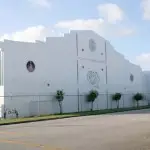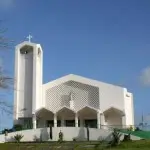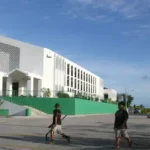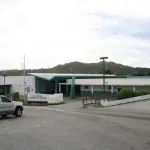Sinajana (Sinahånña)
Table of Contents
Share This
Origin of village name in CHamoru
It is said that wild yams grew plentiful in the lands nestled above the capital village of Hagåtña. These yams were harvested and cooked in earthen ovens dug into the ground, a process known as chinåhan. The village name of Sinajana is believed to derive from this word, from which comes chinahån-ña – “his or her cooking ground.”
Population
The 2010 US Census counted Sinajana village to have a population of 2,592.
Village officials
The current mayor of Sinajana is Robert RDC Hofmann.
Village description
Sinajana is perched along a hilltop between Agana Springs and Agana Heights. When entering the village from San Ramon Hill, one comes upon the Catholic Saint Fidelis Franciscan Friary, whose order maintains Sinajana’s Saint Jude Thaddeus Catholic Church, among others. The annual village fiesta is celebrated on the last weekend of October, in honor of Saint Jude, patron saint of the impossible.
The two main schools are Carlos L. Taitano Elementary School, a public school, and Bishop Baumgartner Memorial School, a private Catholic school.
CL Taitano Elementary School is centrally located within walking distance of the village fire station, St. Jude Thaddeus Church, mayor’s office, and community center. Within this busy block one will also pass the old Won Pat store, which is now an apartment complex. A hotno, or old Spanish oven, can still be found in the yard.
Bishop Baumgartner Memorial School sits on the site of the old Saint Jude Thaddeus Junior High School campus. The Sinajana Community Center houses mayoral administrative offices, the Senior Citizen Recreational Center, Guma’ Mami, Inc., and sports facilities for basketball and baseball. Since the 1950s and 1960s, basketball and baseball have been the principal form of recreation for the neighborhood youth and intra-village leagues. In more recent years a street hockey tournament is held during the time of the village fiesta.
Village history
Sinajana was in existence before the arrival of Spanish missionaries in 1668 and was bordered by the areas now known as Cha’ot and Otdot, the present-day Ordot village. This ancient village was the domain of Hineti, a CHamoru who was loyal to the Spanish and the Marianas Mission, and was baptized Don Ignacio de Hineti. On 23 July 1684, at the climax of the CHamoru-Spanish Wars, Hineti joined with the Spaniards and recruited about 50 CHamorus, armed with lances, to secure the Spanish stockade and the Spanish flag in Hagåtña from CHamoru homeland defenders. For this, he was awarded the position and title of sergeant major by the Spanish governor Captain General D. Antonio de Saravia.
The last Spanish census, taken in 1897, listed 133 residents in Sinajana. There were family names that still exist today, including Quidachay, Fegurgur, Atoigue, Taisague, Concepcion, Agualo, San Nicolas, Dela Rosa, Taimanglo, Gogo, Quichocho, Agui, Neputi, Lujan, Tedtaotao, Achaigua, Matanane, Navaro, Castro, Crisostimo, Balajadia, and Fejeran.
Although pre-World War II Sinajana was an agricultural village, at one time operating as the coffee capital of the island and supplying all of civilian Guam, much has changed with modern urbanization. The destruction of Hagåtña during WWII sent thousands in search of homes, and Sinajana absorbed many families when the US military government erected temporary housing in the village. By 1950, the population had swelled to 3,000.
St. Jude Junior High School, built in 1955 under the guidance of Sinajana pastor Fr. Raymond Demers, had the distinction of being the only school on island built entirely through “happy labor.” More than 500 men from the village volunteered for the construction. The Franciscan Sisters of Perpetual Adoration, from Lacrosse, Wisconsin, administered the school at the request of Bishop Apollinaris William Baumgartner, after whom the school is now named.
Also in the village at one time was the former George Washington High School campus, which was later moved to Mongmong and finally to its present location in Mangilao. CL Taitano Elementary School was previously known as Sinajana Elementary School before being renamed after the former educator and village resident.
After Supertyphoon Karen destroyed eighty percent of the village structures in 1962, the next decade ushered in an onslaught of unimaginable change, as “urban renewal” forced the relocation of hundreds of villagers to other parts of the island, changing forever the lives of those families who lost their link to the old concept of Sinajana village life.
Points of interest
Village map
Institutions
Bishop Baumgartner Memorial School
This kindergarten to eighth grade school is part of the Catholic School System. The school, formerly called St. Jude’s Catholic School, was renamed in honor of Bishop Apollinaris William Baumgartner, OFM Cap, DD who came to Guam on 23 October 1945. Bishop Baumgartner was instrumental in laying the foundation of the island’s Catholic school system.
CL Taitano Elementary School
This school is one of the elementary schools of the Guam Public School System. It was established in 1958 as Sinajana Elementary School and renamed in 1970 to honor the late Carlos Lizama Taitano who was a public servant and civic leader.
St. Jude Church
St. Jude Thaddeus Catholic Church, located in the heart of the village near the Sinajana mayor’s office and Community Center and the Guam Housing and Urban Renewal Authority (GHURA), was rebuilt and rededicated after Supertyphoon Pongsona partially destroyed it on 8 December 2002.
Historical
Ada’s Funeral Home
Ada’s Funeral Home was the first funeral home to operate on island, and continues to be operated by the Ada family.
Butler’s Store
Butler’s Emporium is situated on Route 4, next to Leonard’s White House. It is the longest continuing business on Guam. Next to the building the concrete foundation is the only remnant remaining of the Coca-Cola bottling factory owned by the Butlers. In the 1920s, founder Chester Butler was the first person to receive a license to manufacture and sell the soda outside the continental US.
Hotno
The old Won Pat store is located across from the fire station. In the yard can be found an old Spanish stone oven, or hotno.
Village mayors/commissioners
- Robert Hofmann, Mayor, 2013-Present
- Roke B. Blas, Mayor, 2005-2012
- Daniel E. Sablan, Mayor, 1997-2005
- Francisco N. Lizama, Commissioner/Mayor, 1981-1997
- Ignacio N. Sablan, Commissioner, 1973-1981
- Alfonso M. Pangelinan, Commissioner, 1968-1973
- Francisco R. Santos, Commissioner, 1965-1968
- Luis C. Baza, Commissioner, 1957-1965
- Manuel G. Sablan, Commissioner, 1953-1957
- Felipe R. Ignacio, Commissioner, (no dates provided)
Vice mayors/deputy commissioners/assistant commissioners
- Rudy Iriarte, Vice Mayor, 2013-2024
- Robert RC Hofmann, Vice Mayor, 2005-2012
- Vicente SA Lizama, Vice Mayor, 2001-2005
- Roke B. Blas, Vice Mayo,r 1997-2001
- Daniel E. Sablan, Assistant Commissioner/Vice Mayor, 1981-1997
- Margaret D. Mendiola, Assistant Commissioner, 1980-1981
- Francisco N. Lizama, Assistant Commissioner, 1973-1980
- Ignacio N. Sablan, Assistant Commissioner, 1969-1973
- Alfonso M. Pangelinan, Assistant Commissioner, 1965-1967
- Jacinto B. Calvo, Assistant Commissioner, 1961-1965
- Vicente S. Iriarte, Assistant Commissioner, 1957-1961
- Luis C. Baza, Assistant Commissioner, 1944-1957
- Vicente T. Gogue, Deputy Commissioner, 1935
- Juan S. Aflague, Deputy Commissioner, 1935
- Vicente Gogo, Deputy Commissioner, 1931
- Andres Crisostomo, Deputy Commissioner, 1930
Editor’s note: The preceding list was provided by Konsehelon Mahot Guåhan/the Mayor’s Council of Guam.
For further reading
Beaty, Janice J. Discovering Guam: A Guide to its Towns, Trails and Tenants. Tokyo: Tokyo News Service, 1967.
Mayors Council of Guam. “MCOG – Mayors Council of Guam.”
Onedera, Peter R., ed. Nå’an Lugåt Siha gi ya Guåhan (Guam Place Names). Hagåtña: Chamorro Language Commission, 1988.
St. Jude Dedication Souvenir Booklet Committee. Biba St. Jude Thaddeus. Sinajana: St. Jude Booklet Committee, 2003.




